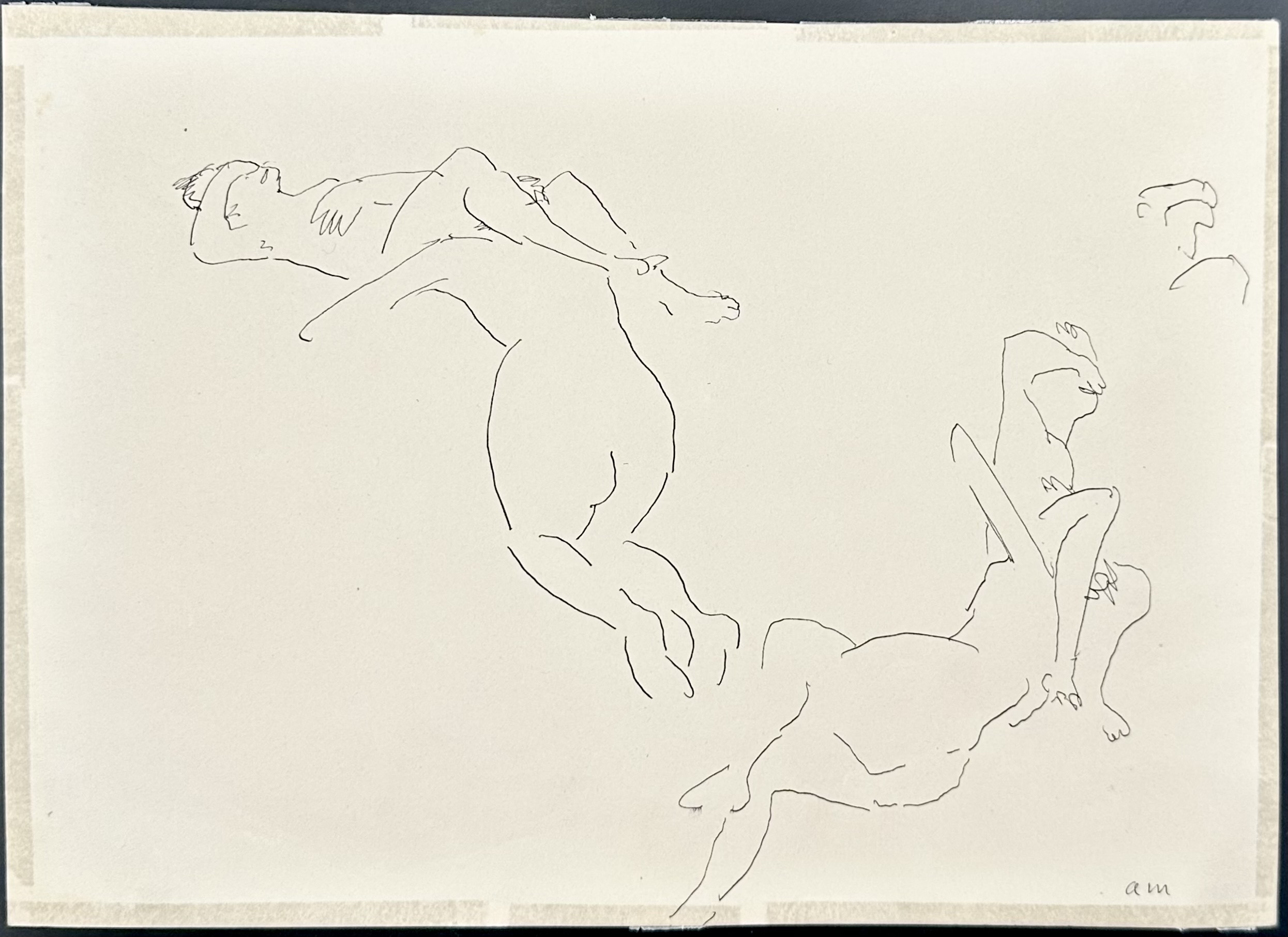
-
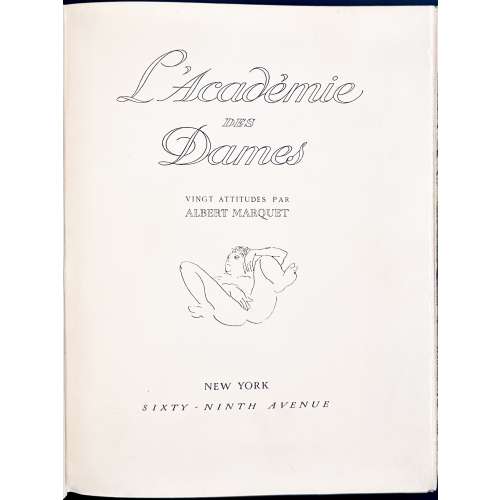 NEWHardcover, 330 x 255 mm, marble paper, two labels of black calf with gilt lettering to spine, 2 blank leaves at front and 2 at back (laid paper), two leaves of lithographic vignettes (t.p. and limitation), plus 20 lithographic plates signed “am”, unpaginated. Limited edition of 25 copies on Japon Impérial paper №№ 1-25, 300 copies on Vélin d’Arches №№ 26-325, of which this is copy № 206. Stones sanded. A poem by Verlaine at p. 2 recto. Title-page: L'Académie | DES | Dames | VINGT ATTITUDES PAR | ALBERT MARQUET | {vignette} | NEW YORK | SIXTY-NINTH AVENUE || Imprint: ÉDITION PRIVÉE | EXEMPLAIRE NUMERO 206 Limitation: JUSTIFICATION DU TIRAGE | IL A ÉTÉ TIRÉ DE CET OUVRAGE | VINGT-CINQ EXEMPLAIRES SUR JAPON IMPÉRIAL | NUMÉROTÉS DE 1 à 25 | ET TROIS CENTS EXEMPLAIRES SUR VÉLIN D'ARCHES | NUMÉROTÉS DE 26 à 325 | PIERRES BIFFÉES || Catalogue raisonné: Dutel III № 949; Nordmann I № 255. Provenance: From the collection of Hans-Jürgen Döpp, Frankfurt. Contributors: Albert Marquet (French, 1875 – 1947) Verlaine, Paul (French, 1844 – 1896) One additional lithographic plate by Marquet from a different source but on a similar subject is laid in.
NEWHardcover, 330 x 255 mm, marble paper, two labels of black calf with gilt lettering to spine, 2 blank leaves at front and 2 at back (laid paper), two leaves of lithographic vignettes (t.p. and limitation), plus 20 lithographic plates signed “am”, unpaginated. Limited edition of 25 copies on Japon Impérial paper №№ 1-25, 300 copies on Vélin d’Arches №№ 26-325, of which this is copy № 206. Stones sanded. A poem by Verlaine at p. 2 recto. Title-page: L'Académie | DES | Dames | VINGT ATTITUDES PAR | ALBERT MARQUET | {vignette} | NEW YORK | SIXTY-NINTH AVENUE || Imprint: ÉDITION PRIVÉE | EXEMPLAIRE NUMERO 206 Limitation: JUSTIFICATION DU TIRAGE | IL A ÉTÉ TIRÉ DE CET OUVRAGE | VINGT-CINQ EXEMPLAIRES SUR JAPON IMPÉRIAL | NUMÉROTÉS DE 1 à 25 | ET TROIS CENTS EXEMPLAIRES SUR VÉLIN D'ARCHES | NUMÉROTÉS DE 26 à 325 | PIERRES BIFFÉES || Catalogue raisonné: Dutel III № 949; Nordmann I № 255. Provenance: From the collection of Hans-Jürgen Döpp, Frankfurt. Contributors: Albert Marquet (French, 1875 – 1947) Verlaine, Paul (French, 1844 – 1896) One additional lithographic plate by Marquet from a different source but on a similar subject is laid in.
-
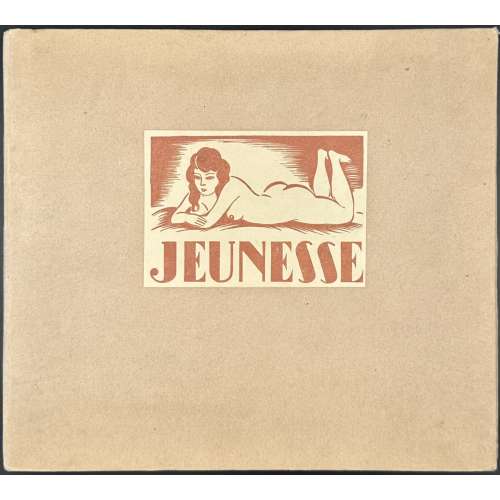 NEWCardboard folder with title label to front, 23.5 x 26.3 cm, containing 12 hand-coloured soft-ground etchings by André Collot, unbound, in a paper folder with pink lettering and vignette engraved on wood, with a title-page in black: JEUNESSE | 12 VERNIS MOUS COLORIÉS | tires à exemplaires | réservés aux Amis de l’Artiste | 1933 || in a frame. First edition, limited to 60 copies. Dutel 1920-70: 1786. There is another copy of the same without the cardboard folder SVE-0469.2021.
NEWCardboard folder with title label to front, 23.5 x 26.3 cm, containing 12 hand-coloured soft-ground etchings by André Collot, unbound, in a paper folder with pink lettering and vignette engraved on wood, with a title-page in black: JEUNESSE | 12 VERNIS MOUS COLORIÉS | tires à exemplaires | réservés aux Amis de l’Artiste | 1933 || in a frame. First edition, limited to 60 copies. Dutel 1920-70: 1786. There is another copy of the same without the cardboard folder SVE-0469.2021. -
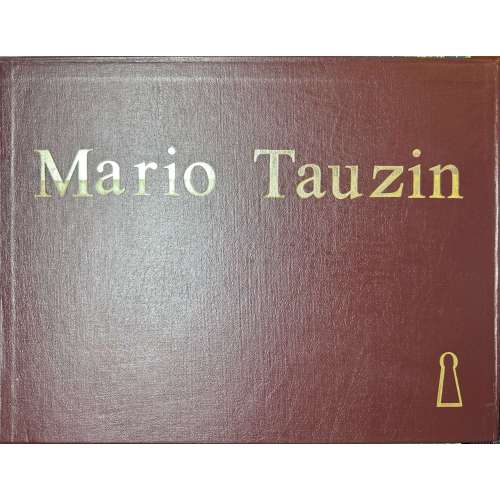 Set of 30 lithographic plates printed on watermarked Van Gelder Simili Japon wove paper, loose in two rexine-backed stiff paper wrappers, 15 in each, together in rexine portfolio with gilt lettering and keyhole on front cover. According to the seller, these are facsimiles of prints/ drawings by Mario Tauzin. Scenes from the series 'Interdit aux adultes'. No publisher indicated; printed in about 1950—a limited edition. Six of these designs used to illustrate 'Bonne à tout faire' were published by Éric Losfeld in the late 1950s (LIB-3293.2024). Dimensions: sheet 320 x 420 mm; album 330 x 430 mm. Contributor: Mario Tauzin (French, 1909 – 1979) — artist
Set of 30 lithographic plates printed on watermarked Van Gelder Simili Japon wove paper, loose in two rexine-backed stiff paper wrappers, 15 in each, together in rexine portfolio with gilt lettering and keyhole on front cover. According to the seller, these are facsimiles of prints/ drawings by Mario Tauzin. Scenes from the series 'Interdit aux adultes'. No publisher indicated; printed in about 1950—a limited edition. Six of these designs used to illustrate 'Bonne à tout faire' were published by Éric Losfeld in the late 1950s (LIB-3293.2024). Dimensions: sheet 320 x 420 mm; album 330 x 430 mm. Contributor: Mario Tauzin (French, 1909 – 1979) — artist -
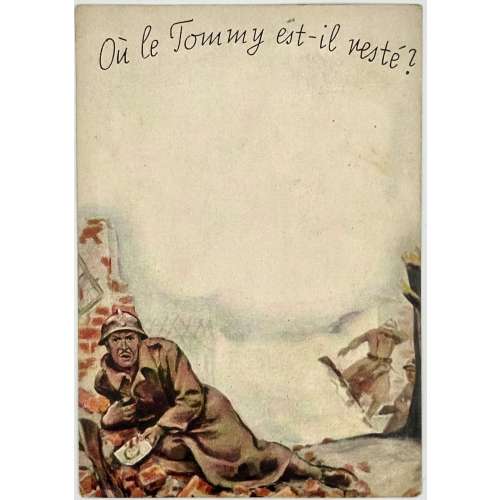 One of a series of six anti-allies propaganda cards, printed in colour, inscribed Ou le Tommy est-il resté? (Where did Tommy stay?), where Tommy is slang for a common soldier in the British Army. The postcards visibly depict French soldiers who fight and die at the western front, while the covert watermark image shows a British military having fun in a bordello. Those cards were printed in the Third Reich for France and dropped from aeroplanes to motivate French soldiers to fight against the British. Size: 149 x 104 mm
One of a series of six anti-allies propaganda cards, printed in colour, inscribed Ou le Tommy est-il resté? (Where did Tommy stay?), where Tommy is slang for a common soldier in the British Army. The postcards visibly depict French soldiers who fight and die at the western front, while the covert watermark image shows a British military having fun in a bordello. Those cards were printed in the Third Reich for France and dropped from aeroplanes to motivate French soldiers to fight against the British. Size: 149 x 104 mm -
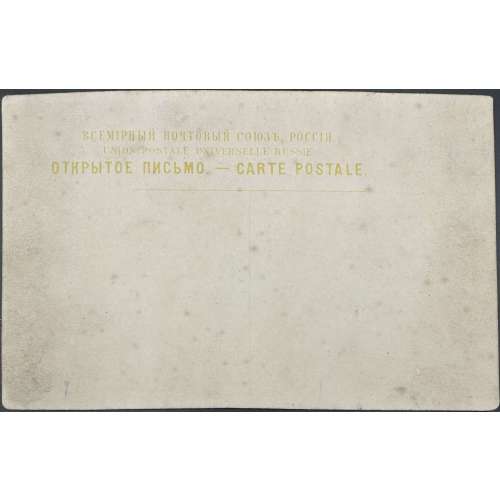 Ten postcards 90 x 140 mm, text in yellow "ВСЕМIРНЫЙ ПОЧТОВЫЙ СОЮЗЪ. РОССIЯ. | UNION POSTALE UNIVERSELLE RUSSIE. | ОТКРЫТОЕ ПИСЬМО. — CARTE POSTALE. || On the reverse, a blue ink woodcut image is printed in the upper left corner, and a blue ink numbered image title is in the bottom centre. Holding the postcard against the backlight reveals a hidden image of an indecent nature (erotic). The use of Latin characters "R" and "N" instead of Russian "Р" and "Н" suggests that the cards were produced in Europe, probably in France. Inscriptions: 1. ПЕRВЫЕ ДNИ; 2. ПОRА ЛЮБВИ; 3. ВЪ ЛЮДИ; 4. КЪ "СВОБОДNОМУ ИСКУССТВУ"; 5. "СВОБОДNЫЙ ТRУДЪ; 6. БЕЗЪ ГОRЯ И ПЕЧАЛИ; 7. NАЗАДЪ КЪ "СВОБОДNОЙ ЛЮБВИ"; 8. ВСЕ ЧТО ОСТАЛОСЬ!; 9. БЕЗЪ КRОВА И ПRИСТАNИЩА; 10. ИЗЪ ЗА ХЛѢБА.
Ten postcards 90 x 140 mm, text in yellow "ВСЕМIРНЫЙ ПОЧТОВЫЙ СОЮЗЪ. РОССIЯ. | UNION POSTALE UNIVERSELLE RUSSIE. | ОТКРЫТОЕ ПИСЬМО. — CARTE POSTALE. || On the reverse, a blue ink woodcut image is printed in the upper left corner, and a blue ink numbered image title is in the bottom centre. Holding the postcard against the backlight reveals a hidden image of an indecent nature (erotic). The use of Latin characters "R" and "N" instead of Russian "Р" and "Н" suggests that the cards were produced in Europe, probably in France. Inscriptions: 1. ПЕRВЫЕ ДNИ; 2. ПОRА ЛЮБВИ; 3. ВЪ ЛЮДИ; 4. КЪ "СВОБОДNОМУ ИСКУССТВУ"; 5. "СВОБОДNЫЙ ТRУДЪ; 6. БЕЗЪ ГОRЯ И ПЕЧАЛИ; 7. NАЗАДЪ КЪ "СВОБОДNОЙ ЛЮБВИ"; 8. ВСЕ ЧТО ОСТАЛОСЬ!; 9. БЕЗЪ КRОВА И ПRИСТАNИЩА; 10. ИЗЪ ЗА ХЛѢБА. -
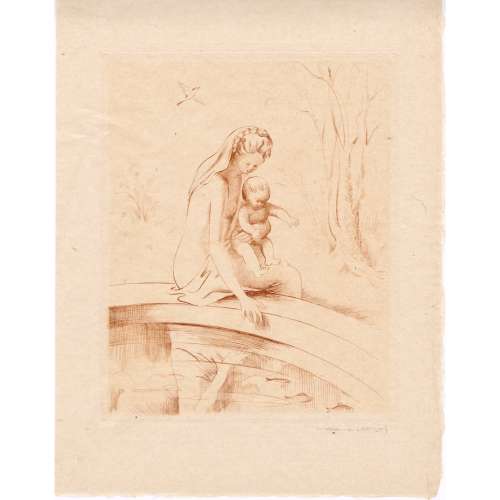 Set of 10 etchings (9 in passe-partout) printed in sanguine on the mother of pearl paper (japon nacre) from the album of 12 prints titled “Jeunesse”, presented by Gérard D'Houville (pen name of Marie de Régnier, née de Heredia) and published by La Tradition in 1945. It was a limited edition of 532 copies, some coloured on Arches paper and some as these set. Plates signed by the artist in pencil below the plate mark. The album cover is missing. Title-page: JEUNESSE | 12 EAUX-FORTES ORIGINALES | DE | MARIANNE CLOUZOT | PRÉSENTÉES | PAR | GÉRARD D'HOUVILLE | {publisher’s device} | LA TRADITION | 1945 || Dimensions: mat 330 x 255 mm; window 225 x 180 mm; sheet 280 x 220 mm; plate 220 x 170 mm. Contributors: Marianne Clouzot (French, 1908 – 2007) – artist Marie de Régnier [Marie de Heredia, Gérard d'Houville] (French, 1875 – 1963) – editor
Set of 10 etchings (9 in passe-partout) printed in sanguine on the mother of pearl paper (japon nacre) from the album of 12 prints titled “Jeunesse”, presented by Gérard D'Houville (pen name of Marie de Régnier, née de Heredia) and published by La Tradition in 1945. It was a limited edition of 532 copies, some coloured on Arches paper and some as these set. Plates signed by the artist in pencil below the plate mark. The album cover is missing. Title-page: JEUNESSE | 12 EAUX-FORTES ORIGINALES | DE | MARIANNE CLOUZOT | PRÉSENTÉES | PAR | GÉRARD D'HOUVILLE | {publisher’s device} | LA TRADITION | 1945 || Dimensions: mat 330 x 255 mm; window 225 x 180 mm; sheet 280 x 220 mm; plate 220 x 170 mm. Contributors: Marianne Clouzot (French, 1908 – 2007) – artist Marie de Régnier [Marie de Heredia, Gérard d'Houville] (French, 1875 – 1963) – editor -
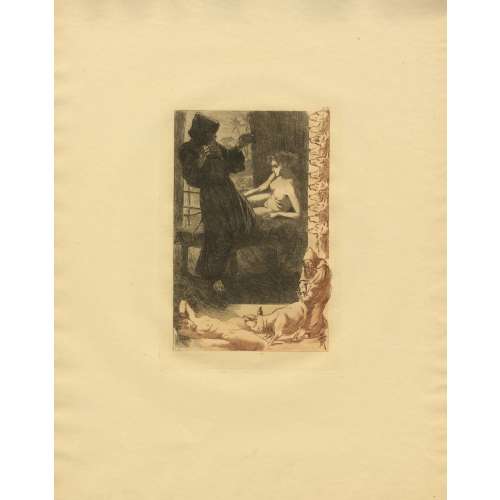 Set of 21 etchings by Martin van Maele for the English edition of ‘Thais’ by Anatole France published in London by Charles Carrington in 1901. Printed on vowe paper without a watermark in two colours with the black image and sepia historiated border. All etchings are inscribed with the artist's monogram; one of the etchings bears inscriptions ORGUEIL, LUXURE, DOUTE (mirror image). Dimensions: sheet: 317 x 250 mm; plate: 170 x 115 mm; image: 155 x 100 mm. Catalogue raisonné: S. A. Perry: № 64. Per Perry, the edition was printed in 500 copies on 'handmade paper watermarked 'Van Gelder'. Contributor: Martin van Maële [Martin, Maurice François Alfred] (French, 1863 – 1926)
Set of 21 etchings by Martin van Maele for the English edition of ‘Thais’ by Anatole France published in London by Charles Carrington in 1901. Printed on vowe paper without a watermark in two colours with the black image and sepia historiated border. All etchings are inscribed with the artist's monogram; one of the etchings bears inscriptions ORGUEIL, LUXURE, DOUTE (mirror image). Dimensions: sheet: 317 x 250 mm; plate: 170 x 115 mm; image: 155 x 100 mm. Catalogue raisonné: S. A. Perry: № 64. Per Perry, the edition was printed in 500 copies on 'handmade paper watermarked 'Van Gelder'. Contributor: Martin van Maële [Martin, Maurice François Alfred] (French, 1863 – 1926) -
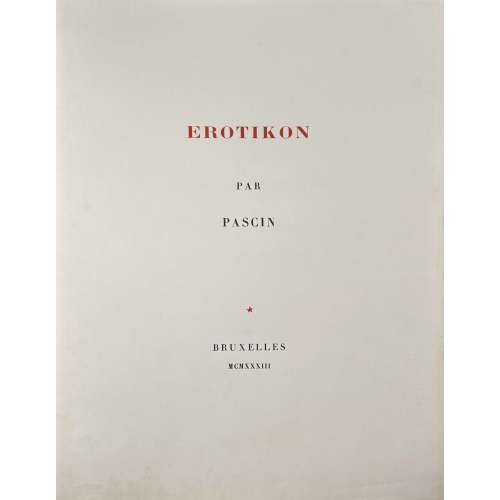 A portfolio of nine heliogravures after Jules Pascin. Cloth-backed cardboard portfolio 420 x 335 mm with 9 heliogravures on slightly tinted india paper, each numbered in pencil and mounted into a passe-partout 410 x 318 mm. Copy № 25 out of 40 printed on india (chine) paper. Copy № 25 of 40. Title (red and black): EROTIKON | PAR | PASCIN | ★ | BRUXELLES | MCMXXXIII || Limitation: CET | ALBUM | A ÉTÉ TIRÉ | A | QUARANTE ET UN EXEMPLAIRES | NUMÉROTÉS | DONT | UN EX. SUR PAPIER ANCIEN | & | QUARANTE EX. SUR CHINE | No (ms 25/40) || Catalogue raisonné: Dutel III № 1498. Seller's description:Neun Heliogravüren. 1933. Meist ca. 30 : 35 cm. Nummeriert. Exemplar 25/40 (Gesamtauflage 41). – Die Heliogravüren auf leicht getöntem China, jedes Blatt mit Bleistift nummeriert und in Passepartouts montiert. – Die neun Passepartouts eingelegt in zwei Büttenumschläge, einer mit Titel und dem nummerierten Auflagenvermerk, der zweite unbedruckt, ferner Büttenumschlag mit Titel in Rotdruck und Halbleinenchemise. – Die Heliogravüren erschienen 1933, drei Jahre nach Pascins Tod bei Daragnes in Paris mit der fingierten Angabe »Brüssel«. – Das berühmte Mappenwerk bildet eine der großen Seltenheiten der erotischen Kunst. Die Motive Pascins beschreibt das Bilderlexikon als »eine Art ›Boheme-Rokoko im Montmartre-Milieu‹« und lobt den Künstler: »Er ist ein außerordentlicher Zeichner, der es versteht, bei allem Zynismus, der seinen exhibitionistischen Charakter nicht verleugnet, auf diesem Kulturdünger eine neuartige Blume voll graziöser Schönheit erblühen zu lassen.« Mappe: 42 : 33,5 cm. – Der äußere Büttenumschlag mit leichtem Wasserrand. – Zwei Heliogravüren minimal stockfleckig, sonst tadellos und absolut vollständig. Dutel 1498 (mit Auflagenvarianten). – Der kalte Blick S. 198ff. – Bilderlexikon II, 718.
A portfolio of nine heliogravures after Jules Pascin. Cloth-backed cardboard portfolio 420 x 335 mm with 9 heliogravures on slightly tinted india paper, each numbered in pencil and mounted into a passe-partout 410 x 318 mm. Copy № 25 out of 40 printed on india (chine) paper. Copy № 25 of 40. Title (red and black): EROTIKON | PAR | PASCIN | ★ | BRUXELLES | MCMXXXIII || Limitation: CET | ALBUM | A ÉTÉ TIRÉ | A | QUARANTE ET UN EXEMPLAIRES | NUMÉROTÉS | DONT | UN EX. SUR PAPIER ANCIEN | & | QUARANTE EX. SUR CHINE | No (ms 25/40) || Catalogue raisonné: Dutel III № 1498. Seller's description:Neun Heliogravüren. 1933. Meist ca. 30 : 35 cm. Nummeriert. Exemplar 25/40 (Gesamtauflage 41). – Die Heliogravüren auf leicht getöntem China, jedes Blatt mit Bleistift nummeriert und in Passepartouts montiert. – Die neun Passepartouts eingelegt in zwei Büttenumschläge, einer mit Titel und dem nummerierten Auflagenvermerk, der zweite unbedruckt, ferner Büttenumschlag mit Titel in Rotdruck und Halbleinenchemise. – Die Heliogravüren erschienen 1933, drei Jahre nach Pascins Tod bei Daragnes in Paris mit der fingierten Angabe »Brüssel«. – Das berühmte Mappenwerk bildet eine der großen Seltenheiten der erotischen Kunst. Die Motive Pascins beschreibt das Bilderlexikon als »eine Art ›Boheme-Rokoko im Montmartre-Milieu‹« und lobt den Künstler: »Er ist ein außerordentlicher Zeichner, der es versteht, bei allem Zynismus, der seinen exhibitionistischen Charakter nicht verleugnet, auf diesem Kulturdünger eine neuartige Blume voll graziöser Schönheit erblühen zu lassen.« Mappe: 42 : 33,5 cm. – Der äußere Büttenumschlag mit leichtem Wasserrand. – Zwei Heliogravüren minimal stockfleckig, sonst tadellos und absolut vollständig. Dutel 1498 (mit Auflagenvarianten). – Der kalte Blick S. 198ff. – Bilderlexikon II, 718. -
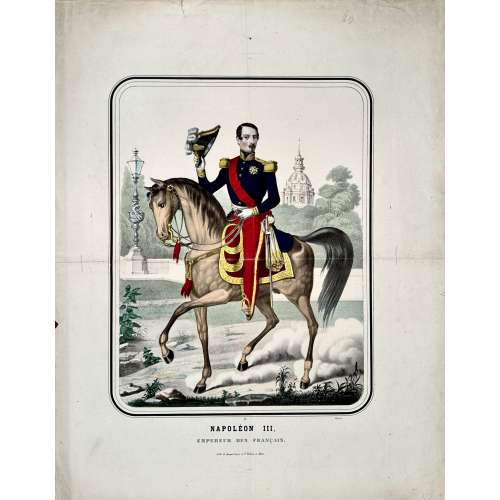 Hand-coloured chromolithography on wove paper, 600 x 470 mm; black ink stamp “4921” to reverse, horizontal and vertical centrefolds. Image of Napoléon III on horseback, in a frame; lettering under the frame: 34 — Déposé | NAPOLÉON III | EMPEREUR DES FRANÇAIS. | Lith. de Gangel frères et P. Didion, à Metz. || Gangel frères et P. Didion (Metz) – printer/publisher. Paulin Didion (French, 1831 – 1879)
Hand-coloured chromolithography on wove paper, 600 x 470 mm; black ink stamp “4921” to reverse, horizontal and vertical centrefolds. Image of Napoléon III on horseback, in a frame; lettering under the frame: 34 — Déposé | NAPOLÉON III | EMPEREUR DES FRANÇAIS. | Lith. de Gangel frères et P. Didion, à Metz. || Gangel frères et P. Didion (Metz) – printer/publisher. Paulin Didion (French, 1831 – 1879) -
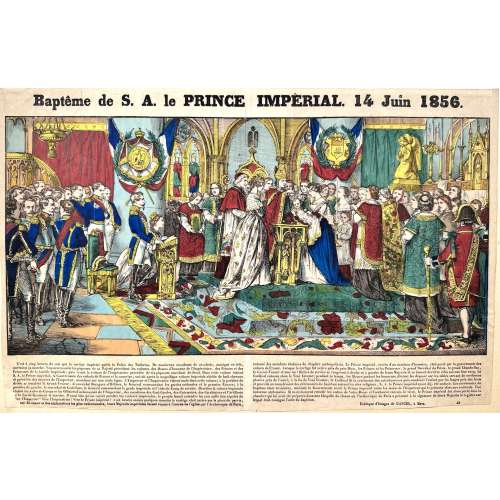 Hand-coloured woodcut on wove paper, 610 x 390 mm; black ink stamp “5207” to reverse, attached to a larger sheet of thick paper with a red ink stamp: “COLLECTION JEAN-CLAUD LACHNITT | REPRODUCTION INTERDIT”. Top: Baptême de S. A. le PRINCE IMPÉRIAL. 14 Juin 1856; image of baptism of Prince-Impérial; two-column text with a small loss in the lower left corner (C'est à cinq heures du soir que le cortège impérial quitta le Palais des Tuileries. De nombreux escadrons de cavalerie, musique en tête ouvraient la marche. ...); bottom under the text: "Fabrique d'Images de GANGEL, à Metz." — "49".
Hand-coloured woodcut on wove paper, 610 x 390 mm; black ink stamp “5207” to reverse, attached to a larger sheet of thick paper with a red ink stamp: “COLLECTION JEAN-CLAUD LACHNITT | REPRODUCTION INTERDIT”. Top: Baptême de S. A. le PRINCE IMPÉRIAL. 14 Juin 1856; image of baptism of Prince-Impérial; two-column text with a small loss in the lower left corner (C'est à cinq heures du soir que le cortège impérial quitta le Palais des Tuileries. De nombreux escadrons de cavalerie, musique en tête ouvraient la marche. ...); bottom under the text: "Fabrique d'Images de GANGEL, à Metz." — "49". -
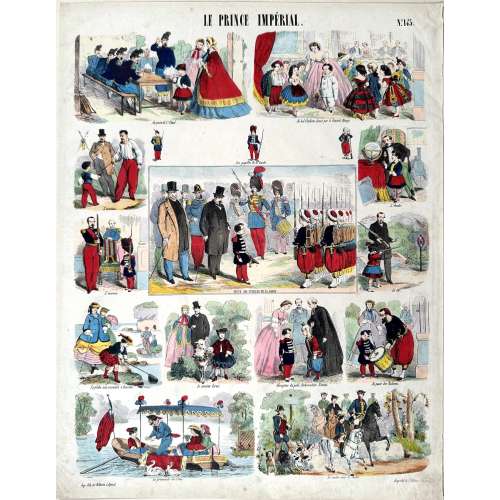 Hand-coloured woodcut on wove paper, 472 x 365 mm; black ink stamp “5275” to reverse. Top centre: "LE PRINCE IMPÉRIAL"; right: "№143." Image in the middle: Prince Impérial, with his father, conducts a review of the children's army "REVUE DES PUPILLES DE LA GARDE". Besides – five tiers of captioned cartoons. Bottom left: "Imp. lith. de Pellerin à Épinal"; right: Propriété de l’Éditeur. Déposé." Jean Charles Pellerin (French, 1756 – 1836) – printer/publisher.
Hand-coloured woodcut on wove paper, 472 x 365 mm; black ink stamp “5275” to reverse. Top centre: "LE PRINCE IMPÉRIAL"; right: "№143." Image in the middle: Prince Impérial, with his father, conducts a review of the children's army "REVUE DES PUPILLES DE LA GARDE". Besides – five tiers of captioned cartoons. Bottom left: "Imp. lith. de Pellerin à Épinal"; right: Propriété de l’Éditeur. Déposé." Jean Charles Pellerin (French, 1756 – 1836) – printer/publisher. -
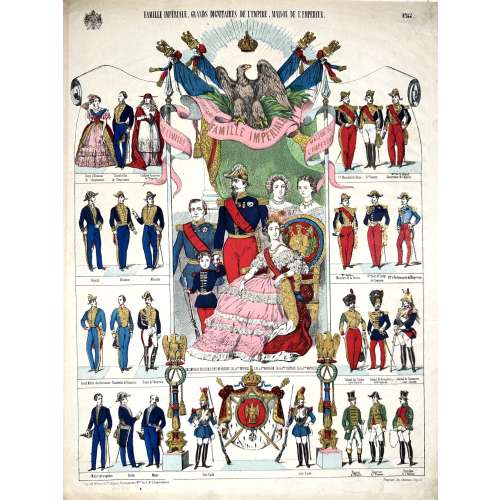 Hand-coloured woodcut on wove paper, 487 x 365 mm; black ink stamp “5056” to reverse. Top left: imperial coat of arms; centre: "FAMILLE IMPERIALE. GRANDS DIGNITAIRES DE L'EMPIRE, MAISON DE L'EMPEREUR."; right: "№144." Image of the imperial family under imperial eagle and standards; besides – four tiers of captioned cartoons. Bottom left: "Imprimerie Lith. de Pellerin, à Épinal"; right: "Propriété de l’Éditeur. — Déposé." Jean Charles Pellerin (French, 1756 – 1836) – printer/publisher.
Hand-coloured woodcut on wove paper, 487 x 365 mm; black ink stamp “5056” to reverse. Top left: imperial coat of arms; centre: "FAMILLE IMPERIALE. GRANDS DIGNITAIRES DE L'EMPIRE, MAISON DE L'EMPEREUR."; right: "№144." Image of the imperial family under imperial eagle and standards; besides – four tiers of captioned cartoons. Bottom left: "Imprimerie Lith. de Pellerin, à Épinal"; right: "Propriété de l’Éditeur. — Déposé." Jean Charles Pellerin (French, 1756 – 1836) – printer/publisher. -
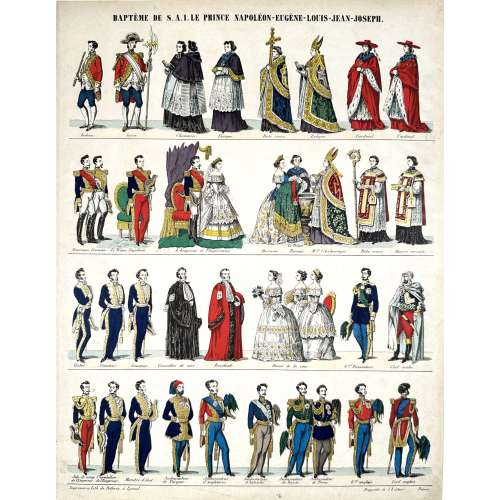 Hand-coloured woodcut on wove paper, 460 x 363 mm; black ink stamp “5054” to reverse. Four tiers with groups of people dressed in uniform, captioned: Bedeau — Suisse — Chanoines — Évêque — Porte croix — Évêque — Cardinal — Cardinal | Généraux français — Le prince Napoléon — L’Empereur et l’Impératrice — Marraine — Le Prince — Parrain | Meur l’Archevêque | Porte crosse Diacre servant | Préfet — Sénateur — Conseiller de cour — Président — Dames de la cour — Gral Piémontais — Chef arabe | Aide-de-camp de l’Empereur — Chambellan de l’Empereur — Ministre d’état — Ambassadeur de Turque | Ambassadeur d’Angleterre — Ambassadeur d’Autriche — Ambassadeur de Russie — Ambassadeur de Prusse — Gral anglaise — Lord anglais || Bottom left: Imprimerie Lith. de Pellerin, à Épinal; right: Propriété de l’Éditeur. — Déposé. Jean Charles Pellerin (French, 1756 – 1836) – printer/publisher.
Hand-coloured woodcut on wove paper, 460 x 363 mm; black ink stamp “5054” to reverse. Four tiers with groups of people dressed in uniform, captioned: Bedeau — Suisse — Chanoines — Évêque — Porte croix — Évêque — Cardinal — Cardinal | Généraux français — Le prince Napoléon — L’Empereur et l’Impératrice — Marraine — Le Prince — Parrain | Meur l’Archevêque | Porte crosse Diacre servant | Préfet — Sénateur — Conseiller de cour — Président — Dames de la cour — Gral Piémontais — Chef arabe | Aide-de-camp de l’Empereur — Chambellan de l’Empereur — Ministre d’état — Ambassadeur de Turque | Ambassadeur d’Angleterre — Ambassadeur d’Autriche — Ambassadeur de Russie — Ambassadeur de Prusse — Gral anglaise — Lord anglais || Bottom left: Imprimerie Lith. de Pellerin, à Épinal; right: Propriété de l’Éditeur. — Déposé. Jean Charles Pellerin (French, 1756 – 1836) – printer/publisher. -
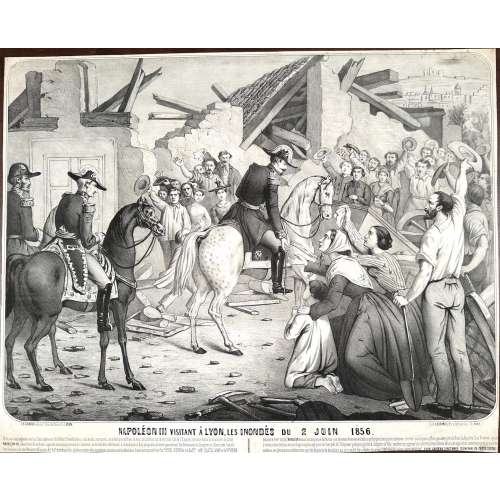 Lithography poster on wove paper, 492 x 614 mm; black ink stamp “5036” to reverse, vertical centerfold. Image in frame; under the frame left: "J. B. Gadola, éditeur. Cours de Brosses 1, à LYON."; right: "Lith LAURANT & Cie r. de Bernardins 34, Paris." Title and text below the image. Jean-Baptiste Gadola (French, 1818 – 1870) – publisher.
Lithography poster on wove paper, 492 x 614 mm; black ink stamp “5036” to reverse, vertical centerfold. Image in frame; under the frame left: "J. B. Gadola, éditeur. Cours de Brosses 1, à LYON."; right: "Lith LAURANT & Cie r. de Bernardins 34, Paris." Title and text below the image. Jean-Baptiste Gadola (French, 1818 – 1870) – publisher. -
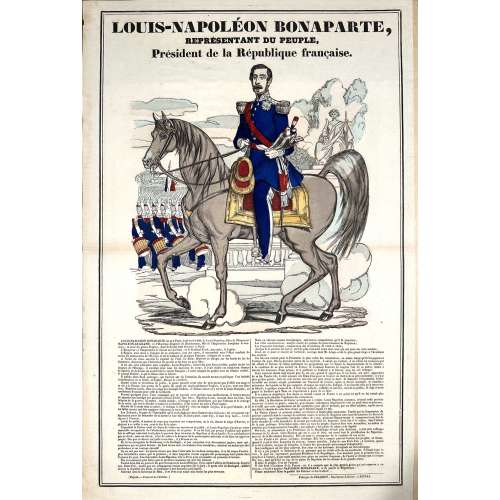 Hand-coloured woodcut poster on wove paper, 622 x 417 mm; black ink stamp “4859” to reverse, horizontal centrefold. In a double frame, top: LOUIS-NAPOLÉON BONAPARTE, | REPRÉSENTANT DU PEUPLE, | Président de la République française. Text under the image ; bottom left: (Déposé.— Propriété de l’Éditeur.); right: Fabrique de PELLERIN, Imprimeur-Libraire, à ÉPINAL. Jean Charles Pellerin (French, 1756 – 1836) – printer/publisher.
Hand-coloured woodcut poster on wove paper, 622 x 417 mm; black ink stamp “4859” to reverse, horizontal centrefold. In a double frame, top: LOUIS-NAPOLÉON BONAPARTE, | REPRÉSENTANT DU PEUPLE, | Président de la République française. Text under the image ; bottom left: (Déposé.— Propriété de l’Éditeur.); right: Fabrique de PELLERIN, Imprimeur-Libraire, à ÉPINAL. Jean Charles Pellerin (French, 1756 – 1836) – printer/publisher. -
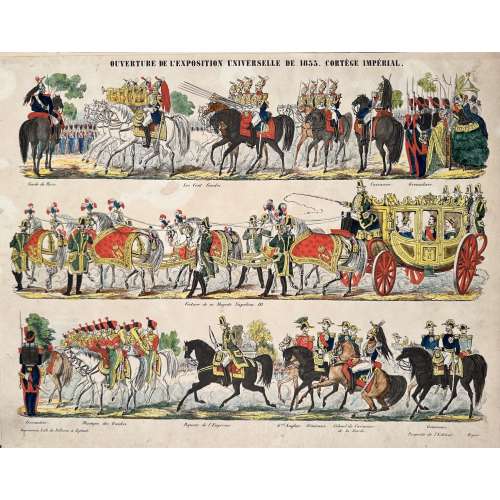 Hand-coloured woodcut on wove paper, 366 x 460 mm; black ink stamp “5057” to reverse. Caption cartoon in 2 tiers. Top: OUVERTURE DE 'EXPOSITION UNIVERSELLE DE 1855. CORTÈGE IMPÉRIAL. Captions top to bottom: Garde de Paris. — Les Cent Gardes. — Cuirassier. — Grenadiers. Middle: Voiture de sa Majesté Napoléon III. | Bottom: Grenadier. — Musique des Guides. — Piqueur de l’Empereur. — Gral Anglais — Généraux — Colonel de Cuirassiers | de la Garde — Généraux. Below left: Imprimerie Lith. de Pellerin, à Épinal; right: Propriété de l’Éditeur. Déposé. Jean Charles Pellerin (French, 1756 – 1836) – printer/publisher.
Hand-coloured woodcut on wove paper, 366 x 460 mm; black ink stamp “5057” to reverse. Caption cartoon in 2 tiers. Top: OUVERTURE DE 'EXPOSITION UNIVERSELLE DE 1855. CORTÈGE IMPÉRIAL. Captions top to bottom: Garde de Paris. — Les Cent Gardes. — Cuirassier. — Grenadiers. Middle: Voiture de sa Majesté Napoléon III. | Bottom: Grenadier. — Musique des Guides. — Piqueur de l’Empereur. — Gral Anglais — Généraux — Colonel de Cuirassiers | de la Garde — Généraux. Below left: Imprimerie Lith. de Pellerin, à Épinal; right: Propriété de l’Éditeur. Déposé. Jean Charles Pellerin (French, 1756 – 1836) – printer/publisher. -
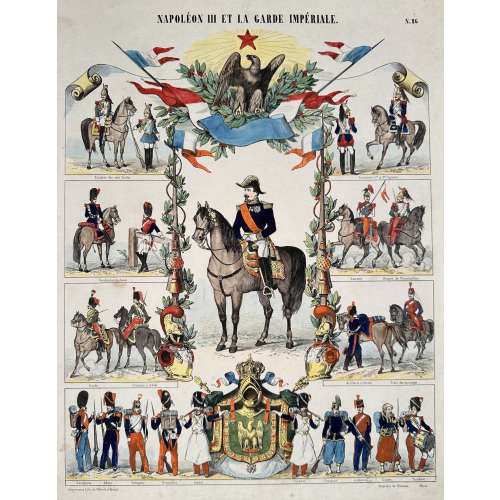 Hand-coloured woodcut on wove paper, 460 x 356 mm; black ink stamp “5055” to reverse. Top centre: "NAPOLÉON III ET LA GARDE IMPÉRIALE"; right: "№ 86". Napoléon III ahorseback in middle, beside (top to bottom): Escadron des cent Gardes — Cuirassiers 1er et 2me regiment; Gendarmes à cheval. — Lancier., Dragon de l’Impératrice.; Guide., Chasseur à cheval. — Artillerie à cheval, Train des équipages.; Gendarme. Génie. Voltigeur. Grenadier. Sapeur. Sapeur. Chasseur. Artillerie. Zouave. Tambour. Bottom left: Imprimerie Lith. de Pellerin à Épinal; right: Propriété de l’Éditeur. Déposé. Jean Charles Pellerin (French, 1756 – 1836) – printer/publisher.
Hand-coloured woodcut on wove paper, 460 x 356 mm; black ink stamp “5055” to reverse. Top centre: "NAPOLÉON III ET LA GARDE IMPÉRIALE"; right: "№ 86". Napoléon III ahorseback in middle, beside (top to bottom): Escadron des cent Gardes — Cuirassiers 1er et 2me regiment; Gendarmes à cheval. — Lancier., Dragon de l’Impératrice.; Guide., Chasseur à cheval. — Artillerie à cheval, Train des équipages.; Gendarme. Génie. Voltigeur. Grenadier. Sapeur. Sapeur. Chasseur. Artillerie. Zouave. Tambour. Bottom left: Imprimerie Lith. de Pellerin à Épinal; right: Propriété de l’Éditeur. Déposé. Jean Charles Pellerin (French, 1756 – 1836) – printer/publisher. -
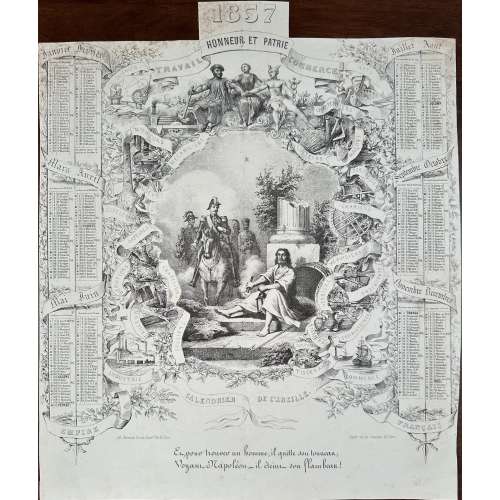 Lithography and etching on wove paper432 x 362 mm, black ink stamp “5022” to reverse, horizontal and vertical centrefolds. Depicts Diogenes (Ancient Greek, 412/404 – 323 BC) beside his barrel and extinguishing his torch when approached by Napoléon III ahorseback. Top: "1857 | HONNEUR ET PATRIE"; lettering on ribbons (top-down): SCIENCES, TRAVAIL, COMMERCE, ARTS, CHARPENTIERS, IMPRIMEURS, "MECHANICIENS, AGRICULTEURS, MAÇONS, FONDEURS, TERRASIERS, CIZELEURS, CARRIERS, ORFEVRES, BIJOUTIERS, CHAPELIERS, MENUISIERS, VERRIERS, SERRURIERS, TAILLEURS, SELLIERS, POTIERS, PORCELAINIERS, CORDONNIERS, TISSERANDS, INDUSTRIE, COMMERCE | CALENDRIER DE L'ABEILLE | EMPIRE, FRANÇAIS. Below left: "lith. Barousse Cour du Comm. 11 et 12. Paris"; right: "Dépôt rue des Cannettes, 20. Paris"; bottom: "Et, pour trouver un homme, il quitte son tonneau, | Voyant Napoléon, – il éteint son flambeau!" [And, to find a man, he leaves his barrel, | Seeing Napoleon, – he extinguishes his torch!]. Six months on the left and six months on the right-hand side of the calendar, surrounding the image.
Lithography and etching on wove paper432 x 362 mm, black ink stamp “5022” to reverse, horizontal and vertical centrefolds. Depicts Diogenes (Ancient Greek, 412/404 – 323 BC) beside his barrel and extinguishing his torch when approached by Napoléon III ahorseback. Top: "1857 | HONNEUR ET PATRIE"; lettering on ribbons (top-down): SCIENCES, TRAVAIL, COMMERCE, ARTS, CHARPENTIERS, IMPRIMEURS, "MECHANICIENS, AGRICULTEURS, MAÇONS, FONDEURS, TERRASIERS, CIZELEURS, CARRIERS, ORFEVRES, BIJOUTIERS, CHAPELIERS, MENUISIERS, VERRIERS, SERRURIERS, TAILLEURS, SELLIERS, POTIERS, PORCELAINIERS, CORDONNIERS, TISSERANDS, INDUSTRIE, COMMERCE | CALENDRIER DE L'ABEILLE | EMPIRE, FRANÇAIS. Below left: "lith. Barousse Cour du Comm. 11 et 12. Paris"; right: "Dépôt rue des Cannettes, 20. Paris"; bottom: "Et, pour trouver un homme, il quitte son tonneau, | Voyant Napoléon, – il éteint son flambeau!" [And, to find a man, he leaves his barrel, | Seeing Napoleon, – he extinguishes his torch!]. Six months on the left and six months on the right-hand side of the calendar, surrounding the image. -
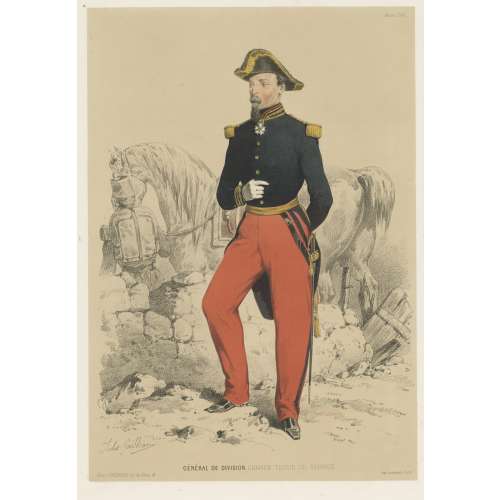 Chromolithography on thick wove paper, 473 x 315 mm sheet, 372 x 260 mm image, black ink stamp “5050” to reverse. Signed on stone "Jules Gaildrau"; below centre: "GÉNERAL DE DIVISION, GRANDE TENUE DE SERVICE"; Bottom left: "Paris, J. Gaildrau, rue de Seine, 16"; right: "Imp. Lemercier, Paris." Joseph Lemercier (French, 1803 – 1887) – printer. Jules Gaildrau (French, 1816 – 1898) – artist.
Chromolithography on thick wove paper, 473 x 315 mm sheet, 372 x 260 mm image, black ink stamp “5050” to reverse. Signed on stone "Jules Gaildrau"; below centre: "GÉNERAL DE DIVISION, GRANDE TENUE DE SERVICE"; Bottom left: "Paris, J. Gaildrau, rue de Seine, 16"; right: "Imp. Lemercier, Paris." Joseph Lemercier (French, 1803 – 1887) – printer. Jules Gaildrau (French, 1816 – 1898) – artist. -
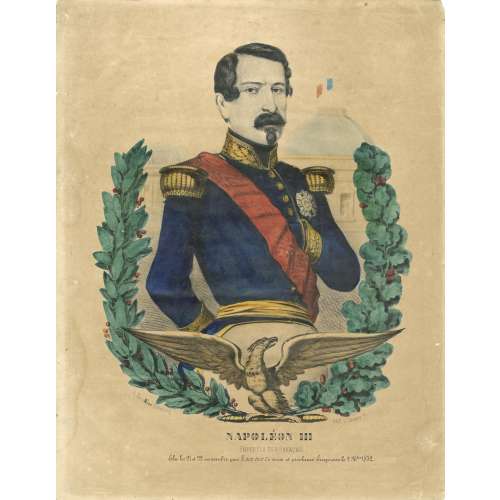 Hand-coloured lithography on wove paper, 380 x 298 mm; black ink stamp “4912” to reverse. On stone left: "A, Paris Miné Éditeur, imp.;" right: "Lith. R. St. Jacques. 41." Bottom center: "Napoléon III"; below: "EMPEREUR DES FRANÇAIS", under: "Élu les 21 el 22 novembre par 8,000,000 de voix et proclamé Empereur le 2 Xbre 1852." Printer/publisher: Miné, éditeur, imprimeur en lithographie, Rue Saint-Jacques, 41. Napoleon III [Charles-Louis Napoléon Bonaparte] (French, 1808 – 1873)
Hand-coloured lithography on wove paper, 380 x 298 mm; black ink stamp “4912” to reverse. On stone left: "A, Paris Miné Éditeur, imp.;" right: "Lith. R. St. Jacques. 41." Bottom center: "Napoléon III"; below: "EMPEREUR DES FRANÇAIS", under: "Élu les 21 el 22 novembre par 8,000,000 de voix et proclamé Empereur le 2 Xbre 1852." Printer/publisher: Miné, éditeur, imprimeur en lithographie, Rue Saint-Jacques, 41. Napoleon III [Charles-Louis Napoléon Bonaparte] (French, 1808 – 1873) -
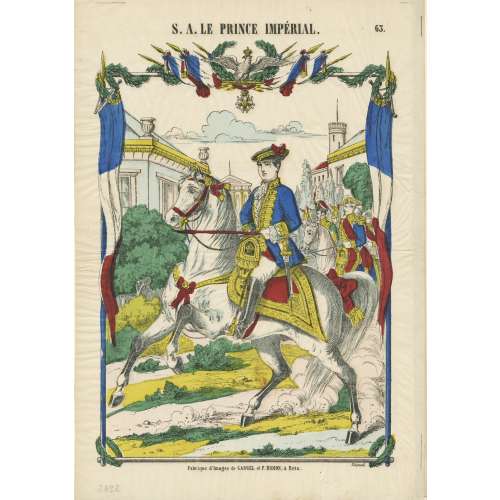 Hand-coloured woodcut on wove paper, 327 x 280 mm; black ink stamp “5265” to reverse, attached to the sheet 470 x 325 mm. Top centre: "S. A. LE PRINCE IMPÉRIAL.", right: "63." Image: equestiral portrait of Prince Impérial. Under the image, centre: "Fabrique d'Images de GANGEL et P. DIDION, à Metz." — "Déposé." Napoléon, Prince Imperial (Napoléon Eugène Louis Jean Joseph Bonaparte] (French, 1856 – 1879). Gangel et P. Didion (Metz); Paulin Didion (French, 1831 – 1879) – publisher/printer.
Hand-coloured woodcut on wove paper, 327 x 280 mm; black ink stamp “5265” to reverse, attached to the sheet 470 x 325 mm. Top centre: "S. A. LE PRINCE IMPÉRIAL.", right: "63." Image: equestiral portrait of Prince Impérial. Under the image, centre: "Fabrique d'Images de GANGEL et P. DIDION, à Metz." — "Déposé." Napoléon, Prince Imperial (Napoléon Eugène Louis Jean Joseph Bonaparte] (French, 1856 – 1879). Gangel et P. Didion (Metz); Paulin Didion (French, 1831 – 1879) – publisher/printer. -
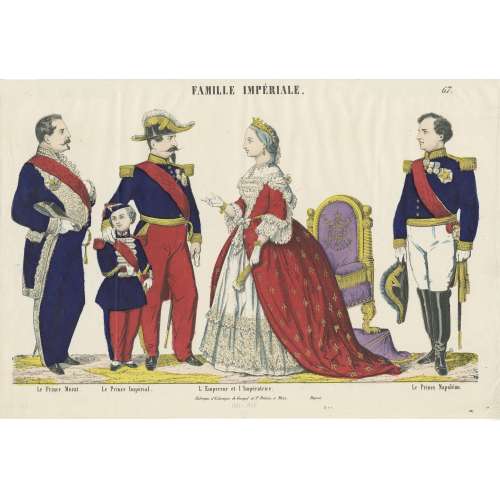 Hand-coloured woodcut on wove paper, 288 x 426 mm; black ink stamp “5305” to reverse. Top centre: "FAMILLE IMPÉRIALE", right: "67." Under the image: "Le Prince Murat." — "Le Prince Impérial." — "L' Empereur et l'Impératrice." — "Le Prince Napoléon." Bottom: "Fabrique d'Estampes de Gangel et P. Didion, à Metz." — "Déposé." Bottom: ms in pencil "1861 – 1868". Publisher/printer: Gangel et P. Didion (Metz); Paulin Didion (French, 1831 – 1879). Characters: Napoleon III [Charles-Louis Napoléon Bonaparte] (French, 1808 – 1873) Eugénie de Montijo [L'impératrice Eugénie] (Spanish-French, 1826 – 1920) Napoléon, Prince Imperial (Napoléon Eugène Louis Jean Joseph Bonaparte] (French, 1856 – 1879) Prince Murat [Lucien Charles Joseph Napoléon] (French, 1803 – 1878) Napoléon-Jérôme Bonaparte [Prince Napoléon] (French, 1822 – 1891)
Hand-coloured woodcut on wove paper, 288 x 426 mm; black ink stamp “5305” to reverse. Top centre: "FAMILLE IMPÉRIALE", right: "67." Under the image: "Le Prince Murat." — "Le Prince Impérial." — "L' Empereur et l'Impératrice." — "Le Prince Napoléon." Bottom: "Fabrique d'Estampes de Gangel et P. Didion, à Metz." — "Déposé." Bottom: ms in pencil "1861 – 1868". Publisher/printer: Gangel et P. Didion (Metz); Paulin Didion (French, 1831 – 1879). Characters: Napoleon III [Charles-Louis Napoléon Bonaparte] (French, 1808 – 1873) Eugénie de Montijo [L'impératrice Eugénie] (Spanish-French, 1826 – 1920) Napoléon, Prince Imperial (Napoléon Eugène Louis Jean Joseph Bonaparte] (French, 1856 – 1879) Prince Murat [Lucien Charles Joseph Napoléon] (French, 1803 – 1878) Napoléon-Jérôme Bonaparte [Prince Napoléon] (French, 1822 – 1891) -
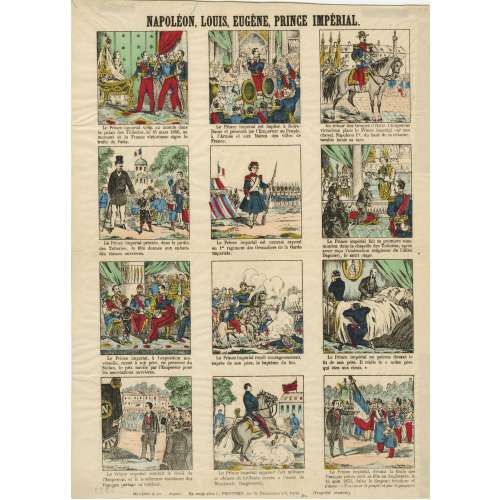 Another copy of SVFC-0745-3.2023, 395 x 290 mm; black ink stamp “5322” to reverse. Jean Charles Pellerin (French, 1756 – 1836)
Another copy of SVFC-0745-3.2023, 395 x 290 mm; black ink stamp “5322” to reverse. Jean Charles Pellerin (French, 1756 – 1836) -
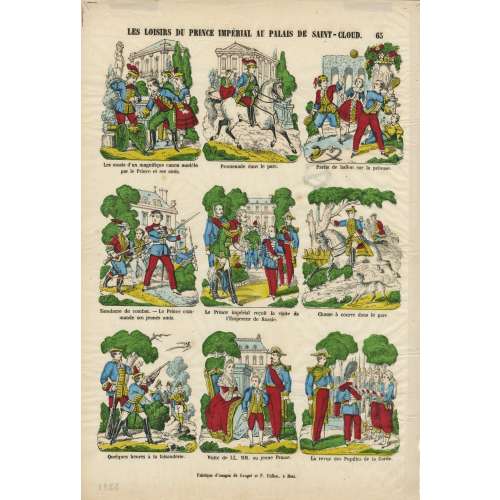 Hand-coloured woodcut on wove paper, 400 x 280 mm; black ink stamp “5321” to reverse. Top: "LES LOISIRS DU PRINCE IMPERIAL AU PALAIS DE SAINT- CLOUD" — "65". Below: nine cartoons with captions.
Hand-coloured woodcut on wove paper, 400 x 280 mm; black ink stamp “5321” to reverse. Top: "LES LOISIRS DU PRINCE IMPERIAL AU PALAIS DE SAINT- CLOUD" — "65". Below: nine cartoons with captions.- Les essais d'un magnifique canon modèle par le Prince et ses amis.
- Promenade dans le parc.
- Partie de ballon sur la pelouse.
- Simulacre de combat. — Le Prince commande ses jeunes amis.
- le Prince impérial reçoit la visite de l'Empereur de Russie.
- Chasse à courre dans le parc.
- Quelques heures à la faisanderie.
- Visite de LL. MM. au jeune Prince.
- La revue des Pupilles de la Garde.
-
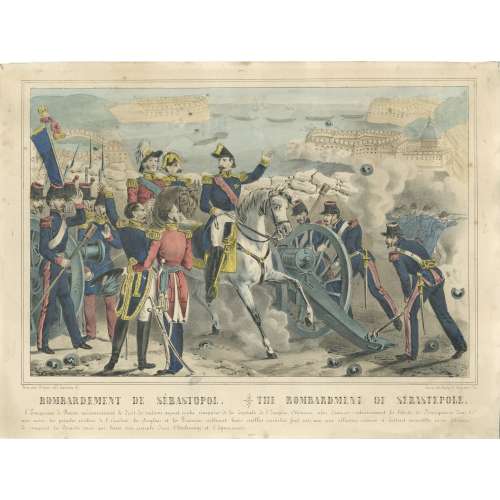 Hand-coloured lithography on wove paper, 250 x 332 mm; black ink stamp “5035” to reverse. Under the frame left: "Paris, chez Riboni, éd. r. Galande, 51"; right: "Paris, lith. Bulla, Pl. Maubert, 26". Below: "BOMBARDEMENT DE SEBASTOPOL. — THE BOMBARDMENT OF SÉBASTOPOLE". Text to bottom. Printers/publishers: Antoine Bulla (fl. 1815 – 1877), François Bulla (fl. c. 1814 – 1855).
Hand-coloured lithography on wove paper, 250 x 332 mm; black ink stamp “5035” to reverse. Under the frame left: "Paris, chez Riboni, éd. r. Galande, 51"; right: "Paris, lith. Bulla, Pl. Maubert, 26". Below: "BOMBARDEMENT DE SEBASTOPOL. — THE BOMBARDMENT OF SÉBASTOPOLE". Text to bottom. Printers/publishers: Antoine Bulla (fl. 1815 – 1877), François Bulla (fl. c. 1814 – 1855). -
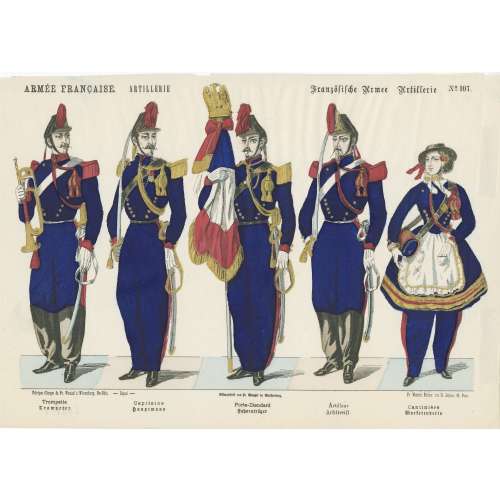 Hand-coloured woodcut on wove paper, 265 x 378 mm; black ink stamp “5051 1” to reverse. Top left: "ARMÉE FRANCAISE. ARTILLERIE"; right: (gothic font) "Französische Armee Artillerie" — "№ 107". Below left: "Fabrique d’Images de Fr. Wentzel à Wissembeurg. Bas-Rhin." — "Déposé" —, centre: "Bilderfabrit von Fr. Wentzel in Weissenburg", right: "Fr. Wentzel, Éditeur, rue St. Jacques, 65, Paris". Bottom: "Trompette | Trompeter" — "Capitaine | Gauptmann" — "Porte-Étendard | Fahnenträger" — "Artilleur | Artillerist" — "Cantinière | Marketenderin". Jean Frédéric Wentzel (French, 1807 – 1869) – publisher/printer.
Hand-coloured woodcut on wove paper, 265 x 378 mm; black ink stamp “5051 1” to reverse. Top left: "ARMÉE FRANCAISE. ARTILLERIE"; right: (gothic font) "Französische Armee Artillerie" — "№ 107". Below left: "Fabrique d’Images de Fr. Wentzel à Wissembeurg. Bas-Rhin." — "Déposé" —, centre: "Bilderfabrit von Fr. Wentzel in Weissenburg", right: "Fr. Wentzel, Éditeur, rue St. Jacques, 65, Paris". Bottom: "Trompette | Trompeter" — "Capitaine | Gauptmann" — "Porte-Étendard | Fahnenträger" — "Artilleur | Artillerist" — "Cantinière | Marketenderin". Jean Frédéric Wentzel (French, 1807 – 1869) – publisher/printer. -
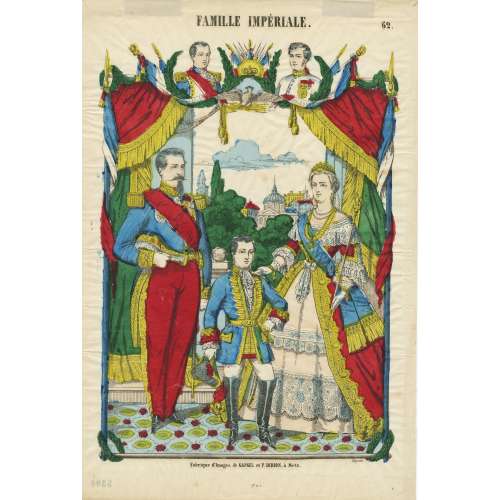 Hand-coloured woodcut on wove paper, 400 x 270 mm; black ink stamp “5306” to reverse. Top centre: "FAMILLE IMPÉRIALE", right: "62."; below centre: "Fabrique d'Images de GANGEL et P. DIDION, à Metz."; right: "Déposé." Publisher/printer: Gangel et P. Didion (Metz); Paulin Didion (French, 1831 – 1879). Characters: Napoleon III [Charles-Louis Napoléon Bonaparte] (French, 1808 – 1873) Eugénie de Montijo [L'impératrice Eugénie] (Spanish-French, 1826 – 1920) Napoléon, Prince Imperial (Napoléon Eugène Louis Jean Joseph Bonaparte] (French, 1856 – 1879) Napoléon II [Napoléon François Joseph Charles Bonaparte] (French, 1811 – 1832) Napoléon Ier [Napoléon Bonaparte] (French, 1769 – 1821)
Hand-coloured woodcut on wove paper, 400 x 270 mm; black ink stamp “5306” to reverse. Top centre: "FAMILLE IMPÉRIALE", right: "62."; below centre: "Fabrique d'Images de GANGEL et P. DIDION, à Metz."; right: "Déposé." Publisher/printer: Gangel et P. Didion (Metz); Paulin Didion (French, 1831 – 1879). Characters: Napoleon III [Charles-Louis Napoléon Bonaparte] (French, 1808 – 1873) Eugénie de Montijo [L'impératrice Eugénie] (Spanish-French, 1826 – 1920) Napoléon, Prince Imperial (Napoléon Eugène Louis Jean Joseph Bonaparte] (French, 1856 – 1879) Napoléon II [Napoléon François Joseph Charles Bonaparte] (French, 1811 – 1832) Napoléon Ier [Napoléon Bonaparte] (French, 1769 – 1821) -
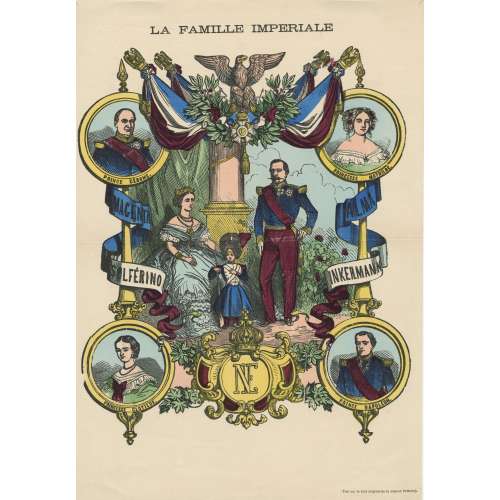 Hand-coloured woodcut on laid paper, 422 x 294 mm; black ink stamp “5307” to reverse, centrefold. Top center: "LA FAMILLE IMPERIALE"; Bottom right: "(Tire sur le bois original de maison Pellerin)". Image: Napoléon III, Empress Eugenie, and Prince Imperial Louis-Napoléon as a child surrounded with four lettered medallions: “PRINCE GÉROME”, “PRINCESSE MATHILDE”, “PRINCESSE CLOTILDE”, and “PRINCE NAPOLÉON”; ribbons lettered: “MAGENTA”, SOLFERINO”, “ALMA”, and “INKERMANN” around heraldic spears; coat of arms with imperial monogram between Princesse Clotilde and Prince Napoléon. Publisher/printer: Jean Charles Pellerin (French, 1756 – 1836). Battle of Magenta : 4 June 1859, against the Austrians. Battle of Solferino : 24 June 1859, against the Austrians. Battle of the Alma : 20 September 1854 (Crimean War) Battle of Inkerman : 5 November 1854 (Crimean War) Characters: Napoleon III [Charles-Louis Napoléon Bonaparte] (French, 1808 – 1873) Eugénie de Montijo [L'impératrice Eugénie] (Spanish-French, 1826 – 1920) Napoléon, Prince Imperial (Napoléon Eugène Louis Jean Joseph Bonaparte] (French, 1856 – 1879) Napoléon-Jérôme Bonaparte [Prince Jérôme] (French, 1822 – 1891) Mathilde Bonaparte [Princess Mathilde] (French, 1820 – 1904) Marie-Clotilde de Savoie [Princesse Clotilde] (French, 1843 – 1911)
Hand-coloured woodcut on laid paper, 422 x 294 mm; black ink stamp “5307” to reverse, centrefold. Top center: "LA FAMILLE IMPERIALE"; Bottom right: "(Tire sur le bois original de maison Pellerin)". Image: Napoléon III, Empress Eugenie, and Prince Imperial Louis-Napoléon as a child surrounded with four lettered medallions: “PRINCE GÉROME”, “PRINCESSE MATHILDE”, “PRINCESSE CLOTILDE”, and “PRINCE NAPOLÉON”; ribbons lettered: “MAGENTA”, SOLFERINO”, “ALMA”, and “INKERMANN” around heraldic spears; coat of arms with imperial monogram between Princesse Clotilde and Prince Napoléon. Publisher/printer: Jean Charles Pellerin (French, 1756 – 1836). Battle of Magenta : 4 June 1859, against the Austrians. Battle of Solferino : 24 June 1859, against the Austrians. Battle of the Alma : 20 September 1854 (Crimean War) Battle of Inkerman : 5 November 1854 (Crimean War) Characters: Napoleon III [Charles-Louis Napoléon Bonaparte] (French, 1808 – 1873) Eugénie de Montijo [L'impératrice Eugénie] (Spanish-French, 1826 – 1920) Napoléon, Prince Imperial (Napoléon Eugène Louis Jean Joseph Bonaparte] (French, 1856 – 1879) Napoléon-Jérôme Bonaparte [Prince Jérôme] (French, 1822 – 1891) Mathilde Bonaparte [Princess Mathilde] (French, 1820 – 1904) Marie-Clotilde de Savoie [Princesse Clotilde] (French, 1843 – 1911) -
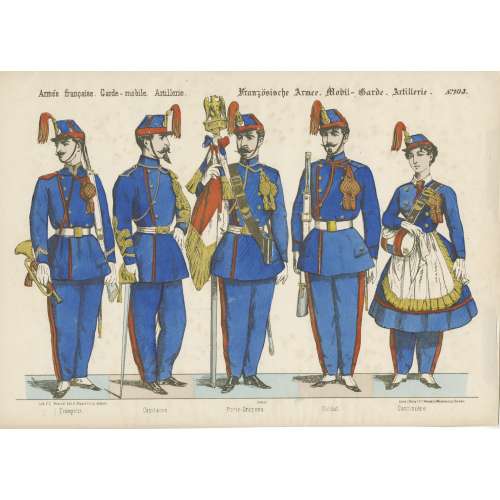 Hand-coloured woodcut on wove paper, 282 x 392 mm; black ink stamp “5051 2” to reverse. Top: "Armée française. Garde–mobile. Artillerie." — (gothic font) "Französische Armee. Mobil–Garde. Artillerie." — "№103". Below left: "Lith F. C. Wentzel édit. à Wissembourg. (Alsacé); center: Déposé; right: Druck u. Verlag v. F. C. Wentzel in Weissemburg. (Elsass)."; Bottom: "Trompette" — "Capitaine" — "Porte-Drapeau". — "Soldat" — "Cantinière." Jean Frédéric Wentzel (French, 1807 – 1869) – publisher/printer.
Hand-coloured woodcut on wove paper, 282 x 392 mm; black ink stamp “5051 2” to reverse. Top: "Armée française. Garde–mobile. Artillerie." — (gothic font) "Französische Armee. Mobil–Garde. Artillerie." — "№103". Below left: "Lith F. C. Wentzel édit. à Wissembourg. (Alsacé); center: Déposé; right: Druck u. Verlag v. F. C. Wentzel in Weissemburg. (Elsass)."; Bottom: "Trompette" — "Capitaine" — "Porte-Drapeau". — "Soldat" — "Cantinière." Jean Frédéric Wentzel (French, 1807 – 1869) – publisher/printer. -
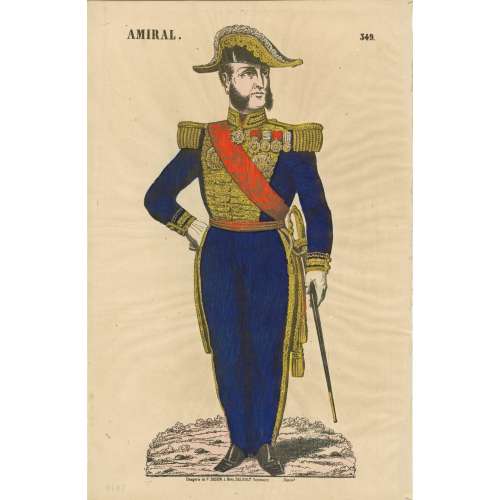 Hand-coloured woodcut on wove paper, 440 x 285 mm; black ink stamp “5049” to reverse. Top left: "AMIRAL"; right: "349". Below: "Imagerie de DIDION, à Metz, DELHALT Successeur." — "Déposé." Paulin Didion (French, 1831 – 1879) – publisher/printer.
Hand-coloured woodcut on wove paper, 440 x 285 mm; black ink stamp “5049” to reverse. Top left: "AMIRAL"; right: "349". Below: "Imagerie de DIDION, à Metz, DELHALT Successeur." — "Déposé." Paulin Didion (French, 1831 – 1879) – publisher/printer. -
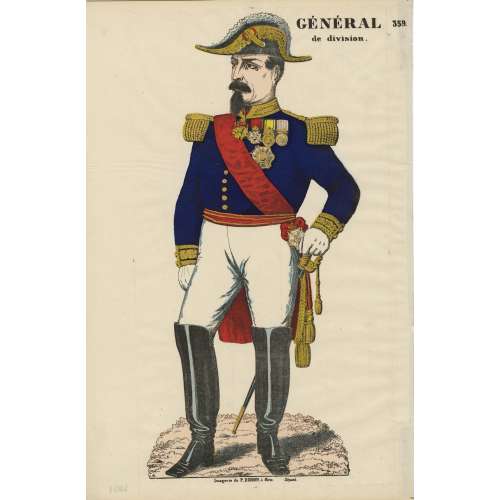 Hand-coloured woodcut on wove paper, 430 x 285 mm; black ink stamp “5051” to reverse. Top right: "GÉNÉRAL | de division." — "359." Bottom: "Imagerie de DIDION, à Metz. Déposé." Paulin Didion (French, 1831 – 1879) – publisher/printer.
Hand-coloured woodcut on wove paper, 430 x 285 mm; black ink stamp “5051” to reverse. Top right: "GÉNÉRAL | de division." — "359." Bottom: "Imagerie de DIDION, à Metz. Déposé." Paulin Didion (French, 1831 – 1879) – publisher/printer. -
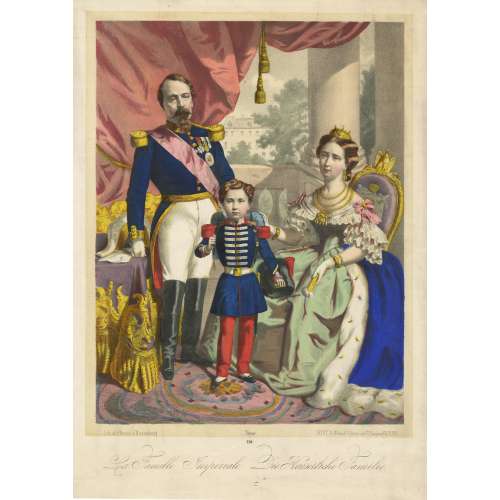 Hand-coloured lithography on wove paper, 395 x 280 mm; black ink stamp “5309” to reverse. On image: artist's initials "L. H."; on stone: "Lith. de Fr. Wentzel a Wissembourg. — Déposé — DÉPÔT, Fr. Wentzel Editeur rue St. Jacques 65, PARIS"; below centre: "239"; bottom : La famille Impériale. Die Kaizerliche Familie. Napoleon III [Charles-Louis Napoléon Bonaparte] (French, 1808 – 1873) Eugénie de Montijo [L'impératrice Eugénie] (Spanish-French, 1826 – 1920) Napoléon, Prince Imperial (Napoléon Eugène Louis Jean Joseph Bonaparte] (French, 1856 – 1879) Jean Frédéric Wentzel (French, 1807 – 1869) – publisher/printer.
Hand-coloured lithography on wove paper, 395 x 280 mm; black ink stamp “5309” to reverse. On image: artist's initials "L. H."; on stone: "Lith. de Fr. Wentzel a Wissembourg. — Déposé — DÉPÔT, Fr. Wentzel Editeur rue St. Jacques 65, PARIS"; below centre: "239"; bottom : La famille Impériale. Die Kaizerliche Familie. Napoleon III [Charles-Louis Napoléon Bonaparte] (French, 1808 – 1873) Eugénie de Montijo [L'impératrice Eugénie] (Spanish-French, 1826 – 1920) Napoléon, Prince Imperial (Napoléon Eugène Louis Jean Joseph Bonaparte] (French, 1856 – 1879) Jean Frédéric Wentzel (French, 1807 – 1869) – publisher/printer. -
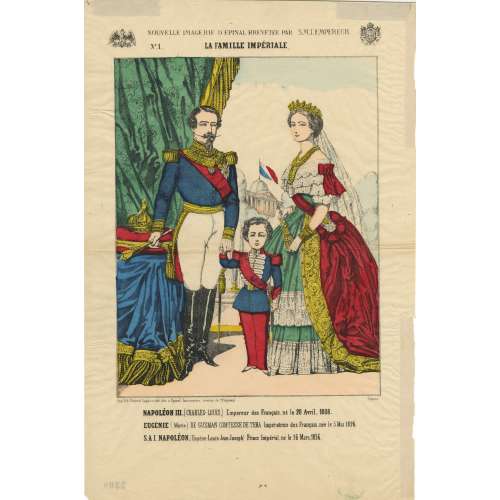 Hand-coloured woodcut on wove paper, 390 x 260 mm; black ink stamp “5308” to reverse; horizontal centerfold. Centre top: "NOUVELLE IMAGERIE D'ÉPINAL BREVETÉE PAR S.M.L’EMPEREUR" with imperial eagle and coat of arms at right and left. Below: "№ 1." — "LA FAMILLE IMPÉRIALE"; image in frame; under the image, left: "Imp lith. Pinot & Sagaire, édit. libr. à Épinal, fournisseurs brevetés de l’Empereur"; right: "Déposé". Bottom: "NAPOLÉON I. (CHARLES-LOUIS,) Empereur des Français, né le 20 Avril, 1808. | EUGÉNIE ( Marie) DE GUSMAN COMTESSE DE TEBA Impératrice des Français, née le 5 Mai 1826. | S.A I. NAPOLÉON. (Eugène-Louis-Jean-Joseph) Prince Impérial, ne le 16 Mars. 1856." Napoleon III [Charles-Louis Napoléon Bonaparte] (French, 1808 – 1873) Eugénie de Montijo [L'impératrice Eugénie] (Spanish-French, 1826 – 1920) Napoléon, Prince Imperial (Napoléon Eugène Louis Jean Joseph Bonaparte] (French, 1856 – 1879) Pinot & Sagaire (Épinal, 1861 – 1888) – enterprise, publisher/printer. Charles-François Pinot (French, 1817 – 1879) – publisher/printer.
Hand-coloured woodcut on wove paper, 390 x 260 mm; black ink stamp “5308” to reverse; horizontal centerfold. Centre top: "NOUVELLE IMAGERIE D'ÉPINAL BREVETÉE PAR S.M.L’EMPEREUR" with imperial eagle and coat of arms at right and left. Below: "№ 1." — "LA FAMILLE IMPÉRIALE"; image in frame; under the image, left: "Imp lith. Pinot & Sagaire, édit. libr. à Épinal, fournisseurs brevetés de l’Empereur"; right: "Déposé". Bottom: "NAPOLÉON I. (CHARLES-LOUIS,) Empereur des Français, né le 20 Avril, 1808. | EUGÉNIE ( Marie) DE GUSMAN COMTESSE DE TEBA Impératrice des Français, née le 5 Mai 1826. | S.A I. NAPOLÉON. (Eugène-Louis-Jean-Joseph) Prince Impérial, ne le 16 Mars. 1856." Napoleon III [Charles-Louis Napoléon Bonaparte] (French, 1808 – 1873) Eugénie de Montijo [L'impératrice Eugénie] (Spanish-French, 1826 – 1920) Napoléon, Prince Imperial (Napoléon Eugène Louis Jean Joseph Bonaparte] (French, 1856 – 1879) Pinot & Sagaire (Épinal, 1861 – 1888) – enterprise, publisher/printer. Charles-François Pinot (French, 1817 – 1879) – publisher/printer. -
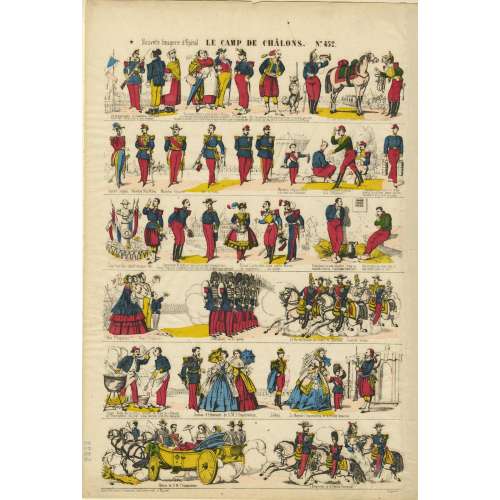 Hand-coloured woodcut on wove paper, 409 x 280 mm; black ink stamp “5323” to reverse; attached to the sheet 487 x 320 mm. Top centre: "LE CAMP DE CHALONS."; left: "Nouvelle Imagerre d'Epinal"; right: № 452. Bottom left: "Imp lith. Pinot & Sagaire, libraires edit. à Épinal"; right: "Déposé". Image: 6-tier cartoon with captions about Napoleon III and his son Prince Imperial (Napoléon Eugène Louis Jean Joseph Bonaparte; 16 March 1856 – 1 June 1879). Le camp de Chalons Pinot & Sagaire (Épinal, 1861 – 1888) – enterprise, publisher/printer. Charles-François Pinot (French, 1817 – 1879) – publisher/printer.
Hand-coloured woodcut on wove paper, 409 x 280 mm; black ink stamp “5323” to reverse; attached to the sheet 487 x 320 mm. Top centre: "LE CAMP DE CHALONS."; left: "Nouvelle Imagerre d'Epinal"; right: № 452. Bottom left: "Imp lith. Pinot & Sagaire, libraires edit. à Épinal"; right: "Déposé". Image: 6-tier cartoon with captions about Napoleon III and his son Prince Imperial (Napoléon Eugène Louis Jean Joseph Bonaparte; 16 March 1856 – 1 June 1879). Le camp de Chalons Pinot & Sagaire (Épinal, 1861 – 1888) – enterprise, publisher/printer. Charles-François Pinot (French, 1817 – 1879) – publisher/printer. -
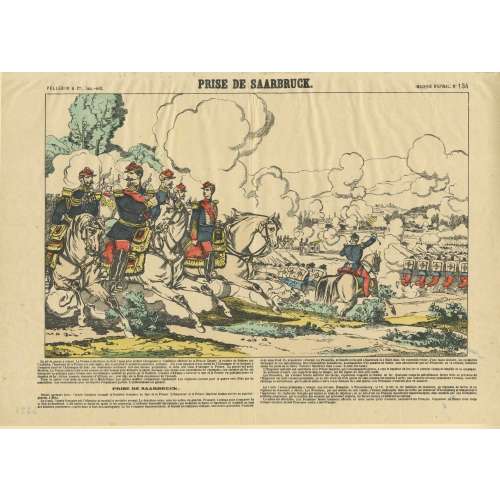 Hand-coloured woodcut on wove paper, 268 x 381 mm, vertical centerfold. On reverse: black ink stamp “5324”. Top centre: "PRISE DE SAARBRUCK"; left: "PELLERIN & Cie, imp. -édit."; right: "IMAGERIE D'EPINAL, № 134." Under the frame text starts with « La cri de guerre a retenti. La France a été forcée de tirer l’épée pour arrêter… ».[...] Prise de Saarbruck. | Depuis quelques jours, l’armée française occupait la frontière française en face de la Prusse.... Jean Charles Pellerin (French, 1756 – 1836) – publisher/printer. The Battle of Saarbrücken (2 August 1870).
Hand-coloured woodcut on wove paper, 268 x 381 mm, vertical centerfold. On reverse: black ink stamp “5324”. Top centre: "PRISE DE SAARBRUCK"; left: "PELLERIN & Cie, imp. -édit."; right: "IMAGERIE D'EPINAL, № 134." Under the frame text starts with « La cri de guerre a retenti. La France a été forcée de tirer l’épée pour arrêter… ».[...] Prise de Saarbruck. | Depuis quelques jours, l’armée française occupait la frontière française en face de la Prusse.... Jean Charles Pellerin (French, 1756 – 1836) – publisher/printer. The Battle of Saarbrücken (2 August 1870). -
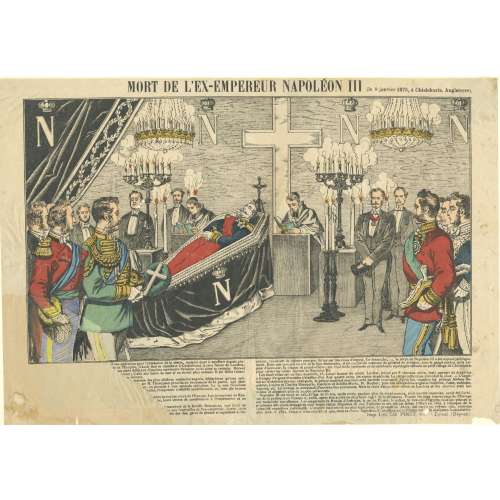 Hand-coloured woodcut on wove paper, 270 x 380 mm; attached to the sheet 303 x 442 mm with pencil ms inscription to the top left corner on the reverse: “Haye le 2-3-75”. Top: "MORT DE L'EX-EMPEREUR NAPOLÉON III (le 9 janvier 1873, à Chislehurts [sic], Angleterre)." Bottom right: "Imp. Lith. CH. PINOT, éditeur. Épinal (Dépose)". Bottom left corner of the image sheet torn and manually restored. Text partially lost, starting with « d’une opération pour l’extraction de la pierre, maladie dont’ il souffrait depuis plu-… ». See Chislehurst. Charles-François Pinot (French, 1817 – 1879) – publisher/printer.
Hand-coloured woodcut on wove paper, 270 x 380 mm; attached to the sheet 303 x 442 mm with pencil ms inscription to the top left corner on the reverse: “Haye le 2-3-75”. Top: "MORT DE L'EX-EMPEREUR NAPOLÉON III (le 9 janvier 1873, à Chislehurts [sic], Angleterre)." Bottom right: "Imp. Lith. CH. PINOT, éditeur. Épinal (Dépose)". Bottom left corner of the image sheet torn and manually restored. Text partially lost, starting with « d’une opération pour l’extraction de la pierre, maladie dont’ il souffrait depuis plu-… ». See Chislehurst. Charles-François Pinot (French, 1817 – 1879) – publisher/printer.


